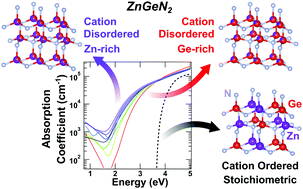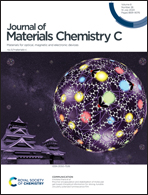Combinatorial investigation of structural and optical properties of cation-disordered ZnGeN2†
Abstract
Cation-disordered ZnGeN2 shows promise for application as a blue-green emitter in light-emitting devices, but more foundational work is necessary to understand structure–property relationships. In this work, we present a combinatorial exploration of the experimental phase space of wurtzite (cation-disordered) ZnGeN2 using high-throughput co-sputtering. Structure, morphology and optical properties are explored as a function of cation composition and synthesis temperature. ZnGeN2 is found to crystallize in the wurtzite structure ranging from Zn-rich to Ge-rich compositions. X-ray diffraction refinements reveal a continuous shift in cell volume with off-stoichiometry, indicating alloy-like structural behavior. The optical absorption of all films examined is lower in energy than the value predicted for cation-ordered ZnGeN2, suggesting that cation disorder is decreasing the bandgap. Additionally, the absorption threshold shifts continuously to higher energy for Ge-rich samples, consistent with bandgap shifts due to alloy-like structural behavior. Defect formation energy diagrams are calculated to help guide understanding of off-stoichiometry from a defect complex perspective. This work paves the way toward use of ZnGeN2 as a bandgap-tunable optoelectronic semiconductor.



 Please wait while we load your content...
Please wait while we load your content...